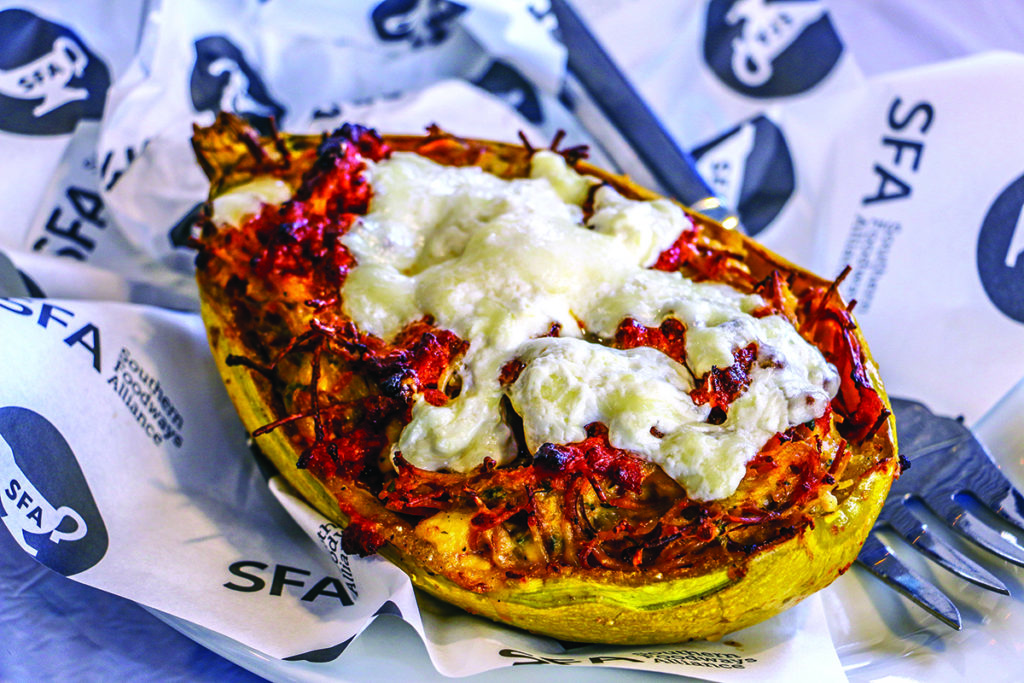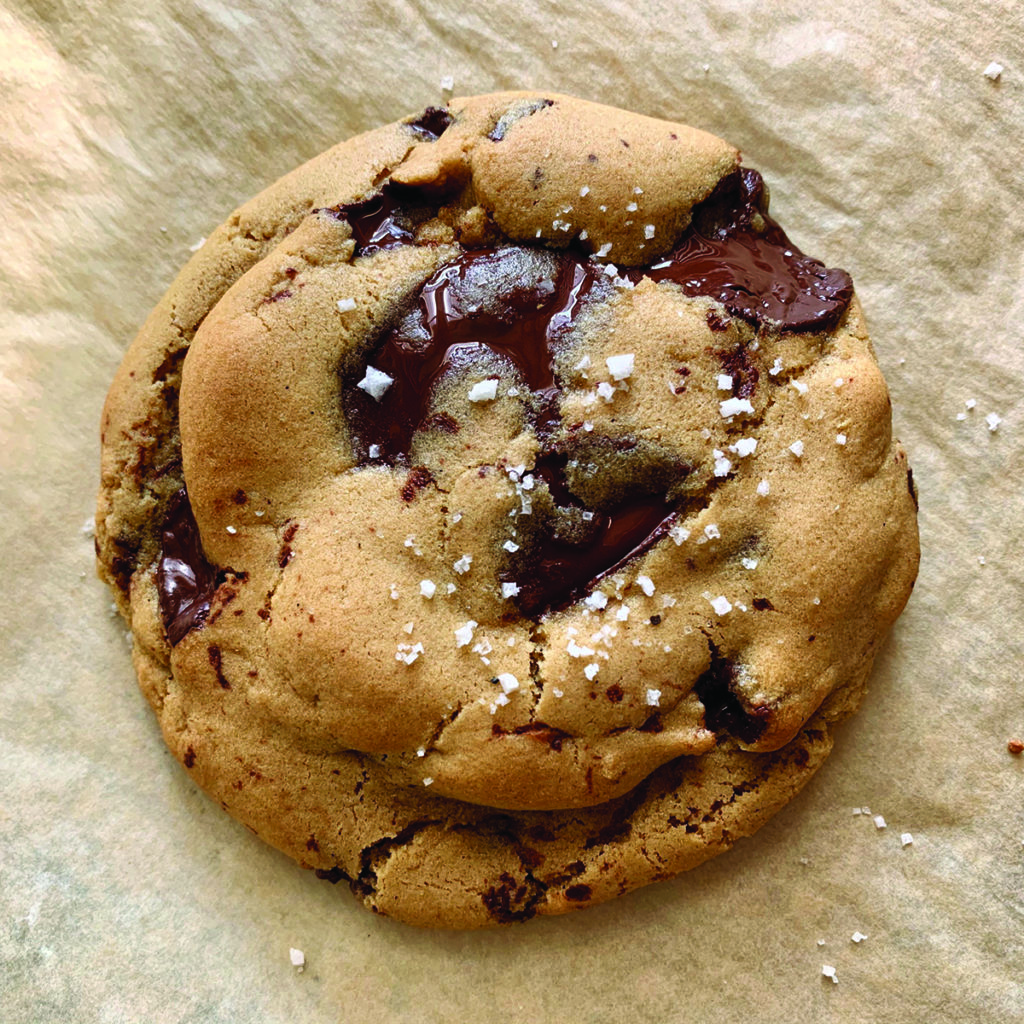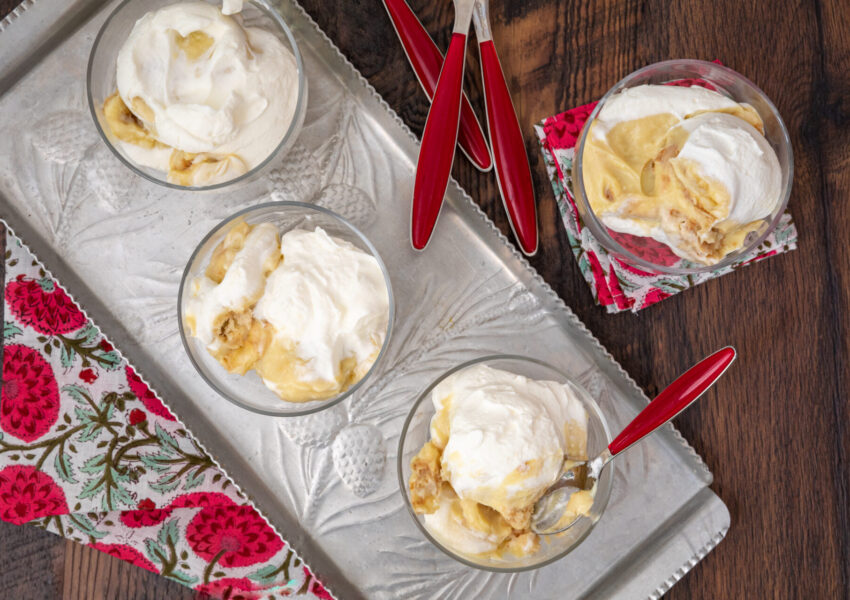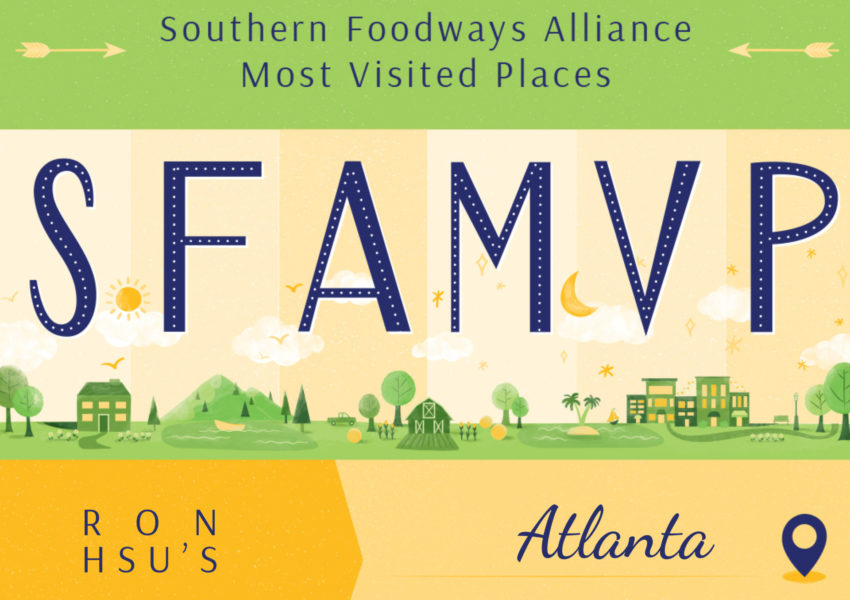Recipe Box Recipes from SFA's 2021 Fall Symposium
At SFA's 2021 Fall Symposium, chefs and bartenders shared dishes and drinks inspired by the environments that have shaped their work and our region. Fresh beets and deep fried grits update a traditional family recipe. Hand-held pastries marry ingredients across continents and cultures. Classic cookies transcend with techniques learned from a mentor. Here, creators share recipes to bring back to your own environment—where, no doubt, they will be adapted anew.
Double-Roasted Spaghetti Squash with Burrata and Marinara Sauce
Sarah Grueneberg
![]()

When I learned that cooks in Mississippi often serve fried catfish with a side of spaghetti with meat sauce, I knew I had to make this twice-roasted squash to accompany a lunch of Simmons Farm-Raised Catfish. The version here calls for marinara sauce; use your favorite, with or without meat.
Serves 4 to 6.
2 small spaghetti squash, about 2 to 2½ lbs. each
Kosher salt and freshly cracked black pepper
1 tablespoon olive oil
1 cup plus 2 tablespoons Parmigiano-Reggiano
1 cup whole milk cottage cheese
2 tablespoons thyme leaves, plus more for garnish
4 ounces fresh burrata or fresh mozzarella, torn into small pieces
2 cups marinara or meaty marinara sauce, warmed
Preheat oven to 425˚F. Nestle the spaghetti squash in a folded kitchen towel on a cutting board to help keep it sturdy while cutting. Using a heavy, sharp chef’s knife or serrated knife, cut the spaghetti squash in half lengthwise. (I find that gentle rocking motions of the knife, first cutting the skin around the squash, make it easier to cut in half.) Using a spoon, scoop out the seeds from the squash and discard.
Line a baking sheet with foil and spray lightly with oil. Generously season the squash halves with salt and pepper and drizzle with the olive oil. Set the squash halves cut side down on the baking sheet. Bake for 30 to 35 minutes, until the squash skin is tender to the touch. Let rest for 10 minutes, then flip; I like to let the squash steam as it slowly cooks. Using a fork, gently pull and shred the squash from the skin — this squash naturally shreds into its namesake spaghetti-like texture. Spread the shredded spaghetti squash on the baking sheet. Set aside the two squash skins for later.
Place the shredded squash back in the oven and roast for 30 minutes, or until slightly caramelized and drier.
Place the double-roasted squash in a medium bowl and mix in 1 cup of the Parmigiano-Reggiano, cottage cheese, thyme, and lots of black pepper. Divide the squash mixture back into the two reserved squash skins. Top the spaghetti squash with the burrata and the remaining Parmigiano-Reggiano.
When ready to serve, set a broiler to high. (Make sure your squash has enough clearance, which is about 3 to 4 inches from the heat source.) Broil the squash for 5 to 6 minutes, or until golden, bubbly, and the skins of the squash are slightly charred. Remove from the oven, garnish with more thyme, and serve with the marinara or meaty marinara sauce on the side.
![]()
Almond Chocolate Chunk Cookies
Caitlin Schumacher
![]()

This recipe is adapted from the version I learned from my friend Michelle Polzine of 20th Century Café in San Francisco. The shaping process can seem tedious, but it’s necessary to create the layers of melted chocolate and dough. My personal touch is using half almond paste and half butter — I enjoy the flavor and puff that the almond paste lends these cookies.
Makes 20 cookies
17 ounces all-purpose flour
1 ¼ teaspoons baking soda
1 ½ teaspoons baking powder
1 ½ teaspoons kosher salt*
5 ounces butter, at room temperature
5 ounces almond paste, at room temperature*
16 ounces muscovado sugar*
1 teaspoon vanilla paste*
2 eggs, at room temperature
12 ounces 70% chocolate pistoles*
Coarse sea salt, for sprinkling
Sift the flour, baking soda, and baking powder into a large bowl. Add the salt and set aside.
In the bowl of an electric mixer fitted with the paddle attachment, paddle the butter and almond paste until well combined. Add the muscovado sugar and vanilla paste. Paddle on medium speed for at least 5 minutes, scraping down around the sides and bottom of the bowl at least once. The mixture should be light and fluffy.
Scrape down the sides of the bowl. With the mixer running on medium-low speed, add the eggs, one at a time.
Stop the mixer and scrape down. Add the flour mixture to the mixing bowl. Paddle on low speed until almost incorporated. Stop mixing when there are still streaks of flour around the edges of the bowl.
Add the chocolate to the mixing bowl. Paddle on low speed for about 5 seconds—you will hear the (super satisfying) crunch, crunch, crunch of the chocolate pistoles breaking apart. Do not overmix! The pistoles should mostly be broken in half, and you want some to stay whole.
On a parchment-lined quarter sheet pan, scrape and pat the dough into an even layer. It should fully fill the pan to the corners and all the way up to the top edges. Wrap in plastic, and chill for several hours or until very firm.
Preheat oven to 350˚F.
Using a metal bench scraper, cut the cold dough (still in the pan) into 20 even pieces. If you like, you can then weigh each piece and adjust to reach a 3-ounce portion. Use the bench scraper to pop the dough blocks out of the pan. Using both hands, and without flattening the dough black (it should stay the same height as it was in the pan), press around the sides of the block to create a hockey puck shape. (It’s OK to have a whole pistole on the top of your cookie.) Continue with the remaining dough.
Place pucks on a parchment-lined sheet pan, leaving plenty of space for spreading (I bake 8 cookies at a time on a half-sheet pan). Sprinkle the tops generously with sea salt.
Bake for about 15 minutes, or until the tops of the cookies look matte and are just starting to pick up golden brown color around the edges. (If using a convection oven, start checking at 11 minutes.)
Let cool completely on the pan. (They will be very fragile for at least an hour—it’s mostly melted chocolate, after all!)
*Ingredient notes: I use King Arthur all-purpose flour for most of my baking — it has a higher protein content than most other all-purpose flours. I only use Diamond Crystal salt, as other brands vary in salinity and coarseness. My preferred brand of almond paste is Mandelin; I also like American Almond. Muscovado sugar is worth seeking out for its deep, complex flavor, but dark brown sugar will do. If you cannot find vanilla paste, you may scrape the seeds from a vanilla bean or use vanilla extract. My favorite baking chocolate is Valrhona Guanaja 70%. Whatever brand you use, the chocolate should be in a pistole (disk) shape to achieve the layers and giant chocolate chunks in this cookie.
Sarah Grueneberg is chef and partner at Monteverde Restaurant and Pastificio in Chicago. A Houston native, she moved to Illinois in 2005 to cook at Spiaggia. She has competed on Top Chef and Iron Chef and hosts the PBS Chicago show Dishalicious. Her first cookbook is forthcoming in fall 2022. Caitlin Schumacher operates Girl Nextdough, a small-batch baking food truck in Charleston, South Carolina. A Chapel Hill native, she first cooked under Karen Barker at Magnolia Grill in Durham, North Carolina, and was SFA’s inaugural Karen Barker Baker at the 2021 Fall Symposium.
SIGN UP FOR THE DIGEST TO RECEIVE GRAVY IN YOUR INBOX.




